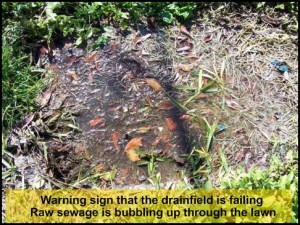 Septic System Failure – Finding the Cause
Septic System Failure – Finding the Cause
There are two main signs of septic system failure:
1. Water backing up into the showers, bathtub, other drains and toilets not flushing.
2. Sewage rising to the surface somewhere in the yard.
Failure usually occurs in either the tank or field.
It’s important to remember that there are different degrees of system failure. Your system could seem to be failing but still be easily fixed because there are a variety of failure causes. In other words, you could have a temporary and inexpensive issue, or a more permanent and expensive problem.
Here are step-by-step instructions for finding the cause:
1. Homeowners can jump to conclusions and think there’s a failure if one or more drains are backed up. Be sure to check all drains in the house. If multiple drains are backed up but some still work, there might be a clog in a main drain branch inside the house. If all the drains are backed up…
2. Open the tank. If the tank is not flooded, you can check drains inside the house, one at a time, to see where the clog is, and you know that the issue is somewhere between the house and the tank. If the tank is flooded, then check the outlet tee. If the outlet tee doesn’t appear to be clogged or broken…
3. You’ll have to either run a plumber’s snake through and/or dig up the tightline (pipe between the septic tank and the drain field). This line frequent breaks do to settling of the heavy concrete tank. If the tightline isn’t clogged or broken…
4. The problem is probably the dreaded failed drain field.
Identifying Cause Based on Symptoms
The common sense approach…consider the “symptoms” of the system. Where is the problem and how bad is it? Use the table below to help answer these questions:
|
No Drains Backed Up |
Drains Backed Up Sometimes |
Drains Backed Up Completely |
|
|
No Effluent in Yard |
Partial clog in house drain, line to septic, or tightline (pipe from tank to field), tank nearly full, distribution box damage or shifting |
Severe clog in house, severe clog in line to septic, severe outlet tee clog, severe tightline clog, tank full |
|
|
Effluent close to house sometimes |
Roots intruding in line from house to tank, partial break of line from house to tank, crack in tank |
Partial break/root intrusion in line to tank |
Complete break/root intrusion in line to tank |
|
Effluent close to house always/flooding |
Large crack in tank |
Complete break/root instrusion in line to tank, break in line from house/tank junction |
Complete break/root intrusion in line to septic |
|
Effluent further from house sometimes |
Partial break/root intrusion in tightline, distribution box shifting/damage, partial drainfield failure |
Distribution box shifting/damage, distribution lines clog/damage, partial drain field failure |
(Unlikely) Severely clogged distribution lines, partial or complete drain field failure |
|
Effluent further from house always/flooding |
Complete break/root intrusion in tightline, severe distribution box shifting/damage, complete drain field failure |
(Unlikely) Distribution box shifting/damage, distribution lines clog/damage, complete drain field failure |
(Unlikely) Complete drain field failure |
| A couple points to keep in mind: (1) The system is meant to be a water tight until it reaches the distribution pipes in the drain field; some of the above conclusions might not make sense without realizing this.(2) You could have more than one issue. For example, you might have a crack in the tank cause effluent close to house sometimes, and a partially clogged line to septic causing drains to be backed up sometimes.(3) It’s unlikely to have the yard completely flooded away from the house and drains completely blocked because the yard being flooded implies that effluent is exiting the house.(4) Since all these observations are judgment calls (difference between sometimes/always and close/further from house), this table is only meant to be guidelines in how to think about issues and isn’t meant to replace the advice of a licensed professional. | |||
